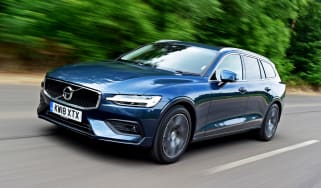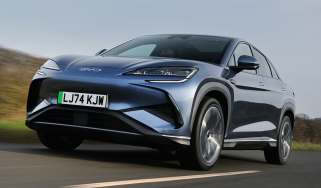Volvo V60 estate – MPG, running costs & CO2
The Volvo V60 offers competitive fuel economy in both mild hybrid and plug-in hybrid guises
Volvo made waves by announcing it would only launch electrified (mild-hybrid, plug-in hybrid or battery electric) models from 2019 and that it’s targeting 50% EV sales by 2025. There’s a very good chance you’re looking at the last Volvo to be launched with a conventional diesel engine, and in late 2021 it was removed from the line-up altogether.
That's a bit of a shame for drivers with a high annual mileage who often head out on the motorway, where extra fuel efficiency starts to pay dividends. We suspect the last batch of diesel V60s may hold their value rather well on the used market.
That said, the petrol mild hybrid V60 still returns respectable fuel economy, while the plug-in hybrids offer a competitive electric driving range and triple-digit mpg figures if you remember to keep the battery topped up.
Volvo V60 MPG & CO2
The B4 mild hybrid petrol engine returns just under 45mpg, which is slightly more than the now-discontinued B3 and B5 petrol models. It’s also marginally better than the similarly-priced BMW 320i Touring and the Mercedes C 200 Estate, while emitting less CO2. However, at 144g/km, it’s still not a wise choice for business drivers.
If you want to run a Volvo V60 company car, the plug-in hybrid V60 T6 and T8 make the most sense, owing to their low CO2 emissions figures of just 17g/km and 18g/km respectively. Combined with the electric driving range of around 56 miles, they fall into the 8% Benefit-in-Kind band – the same as the equivalent plug-in hybrid BMW or Mercedes. Fuel economy officially stands at over 350mpg, which looks astronomical on paper, but will be hard to achieve in the real world unless you mainly drive in electric mode. When we tested the V60 T8, it returned an average of 80mpg, which is still very impressive.
More reviews
Another thing to note is the size of the fuel tank. Both plug-in hybrid Volvos use the same 60-litre tank as the mild hybrid, while the plug-in BMW gets a smaller tank than its petrol equivalent – something that could be frustrating on longer journeys.
If you’re looking for a diesel V60 on the used market, the V60 B4 (D) was fitted with a 2.0-litre engine which returned up to 55.3mpg with CO2 emissions from around 135g/km, depending on trim level.
Now that the entry-level V60 Core has been dropped, every V60 costs over £40,000 before optional extras, meaning there’s no way to avoid the luxury car VED surcharge. As the engines are all electrified in some way, you do benefit from a £10 reduction in annual tax versus a regular petrol car.
Insurance groups
The Volvo V60 starts in insurance group 29, rising to groups 36 and 38 for the T6 and T8 plug-in hybrids respectively. That’s pretty much on par with the BMW 3 Series Touring and Mercedes C-Class Estate but there are other estate cars with cheaper insurance, including the Audi A4 Avant and the Volkswagen Arteon Shooting Brake.
Warranty
Volvo offers a fairly typical three-year or 60,000-mile warranty, which matches the Volkswagen Passat, but BMW and Mercedes do slightly better by removing the mileage limit. It’s worth mentioning that Volvo announced a free windscreen and tyre repair service in early 2022 for Volvos of any age, which demonstrates Volvo’s ongoing commitment to keep their customers safe.
Servicing
Volvo models typically need servicing once a year, and fall under the Volvo Service Promise, a set of guarantees that include a personal service advisor to assist with any questions, a car health check and free software upgrades. Cars serviced by Volvo are also given complimentary annual roadside cover. Volvo has also launched Care by Volvo – a subscription service with a flat monthly fee that includes the car itself and costs like servicing, making payments as simple as a mobile phone contract.












